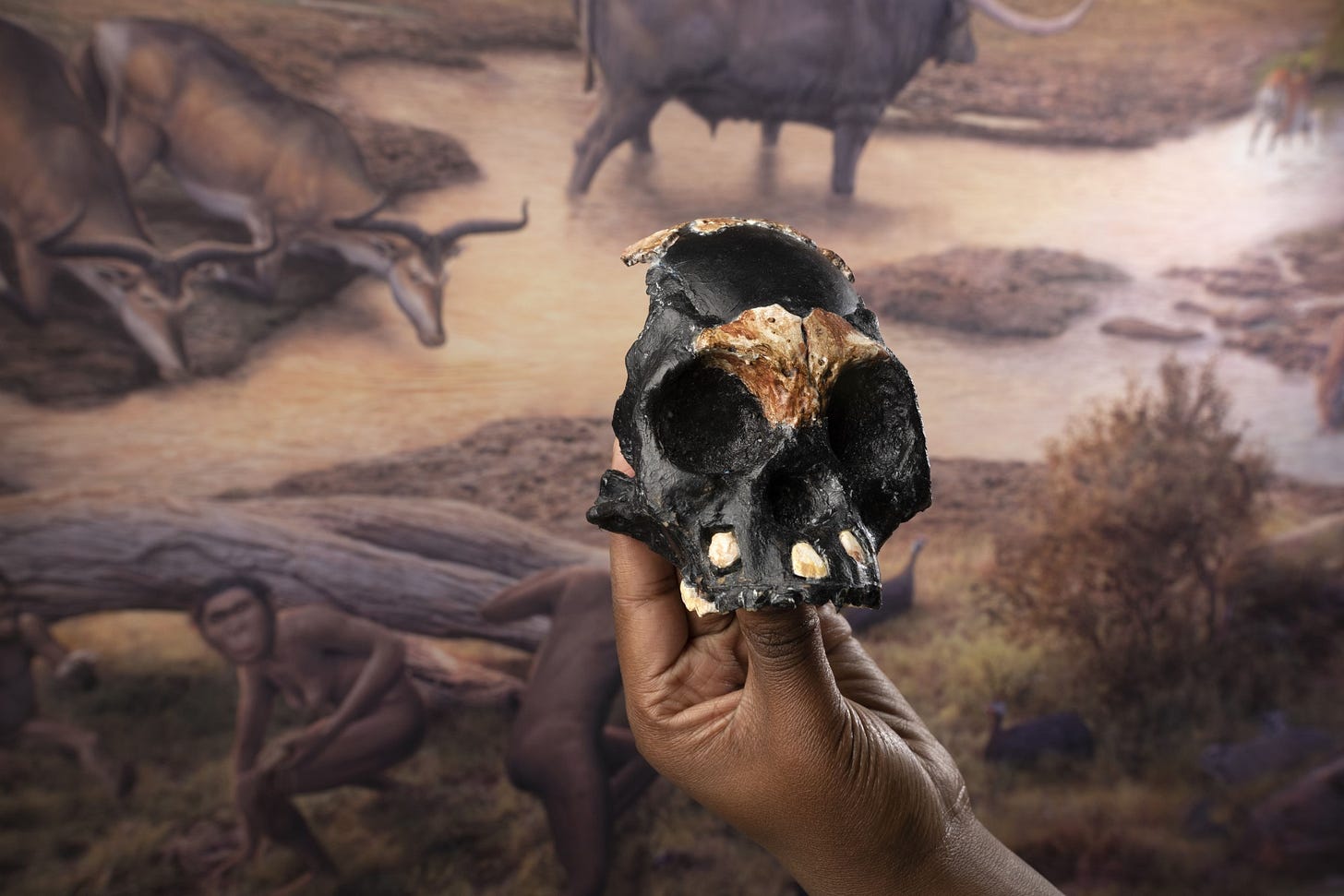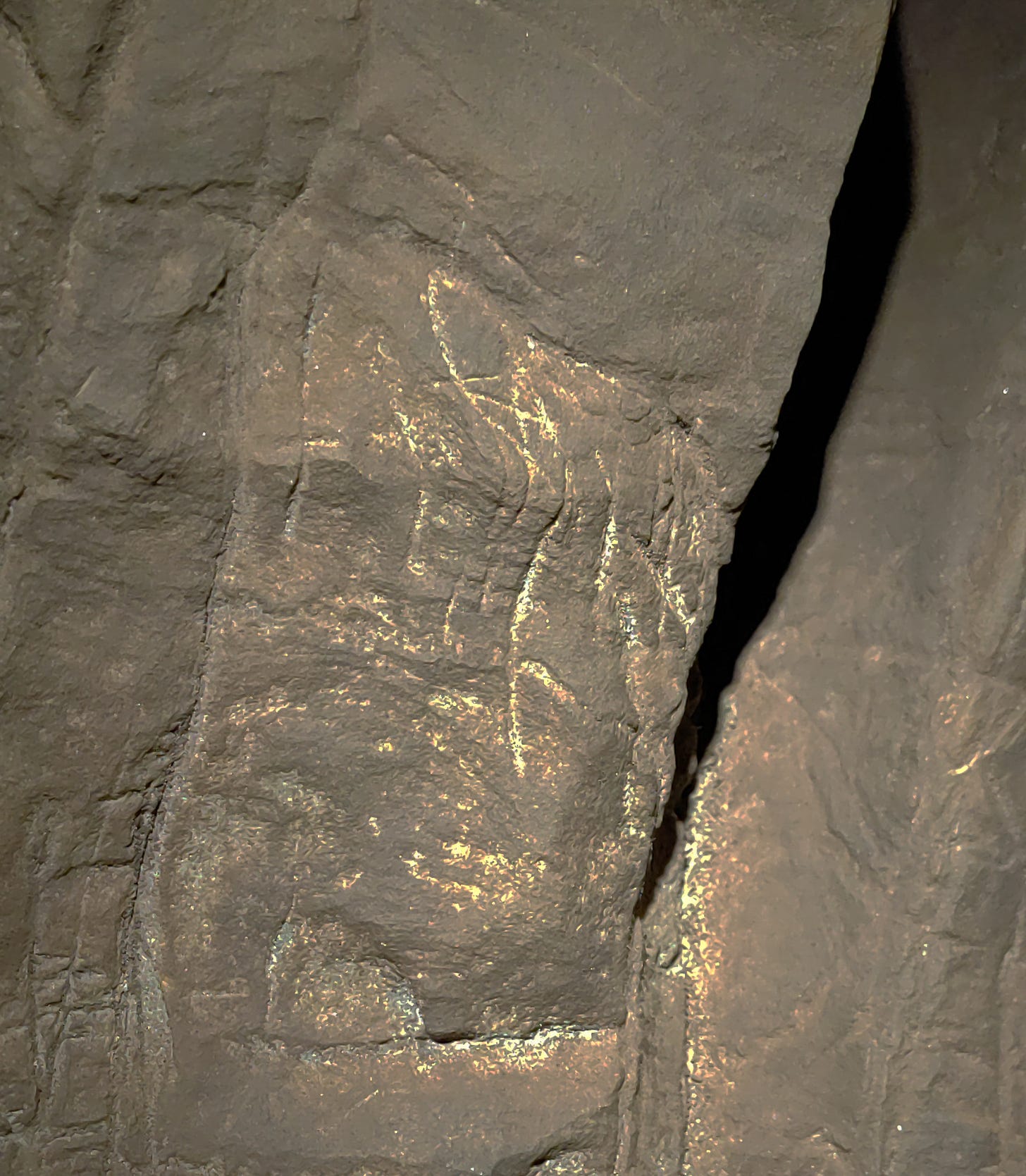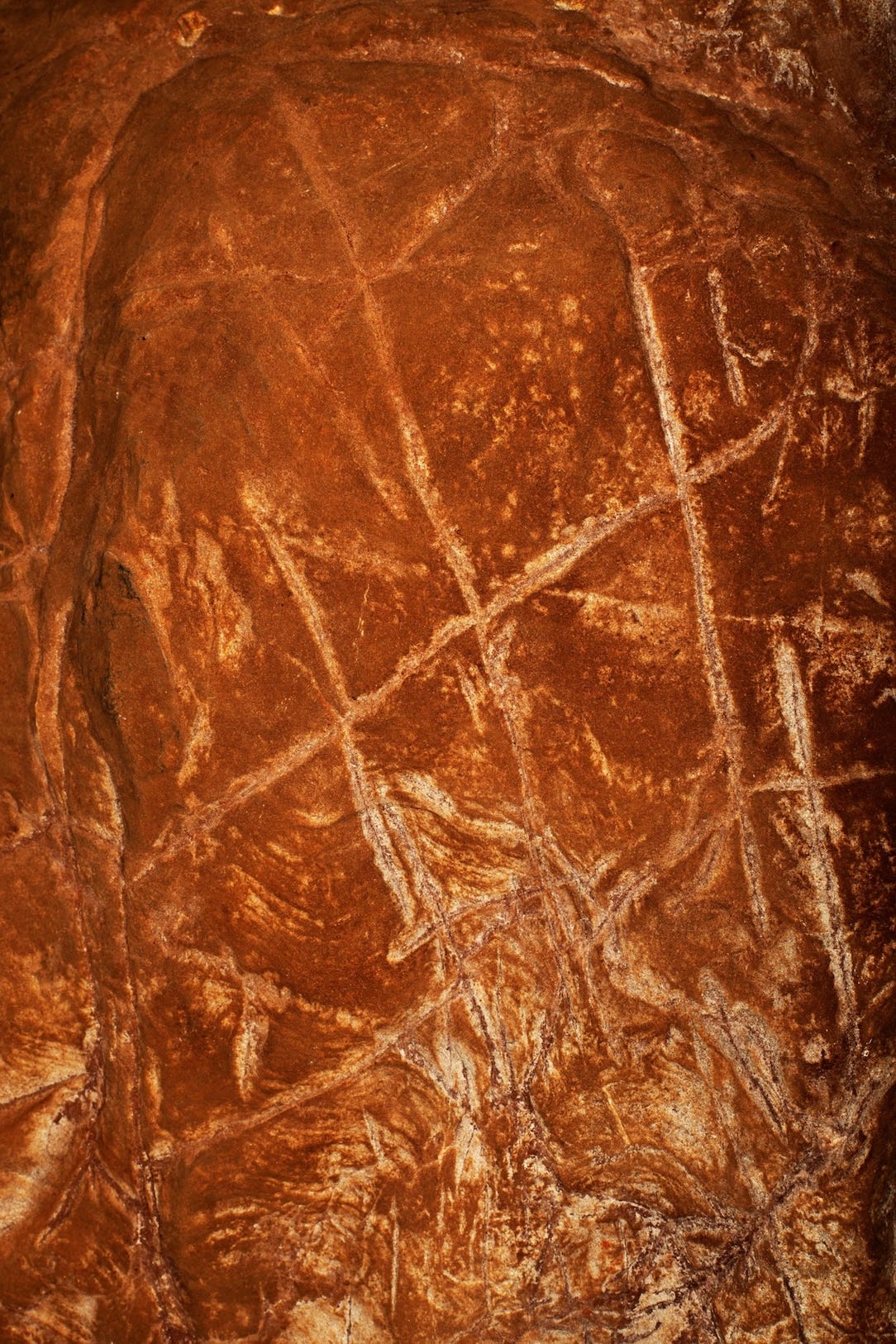[Book Review] Cave of Bones: A True Story of Discovery Adventure and Human Origins
In the longer retelling of the recent discoveries at Rising Star, Lee and coauthor John Hawks provide a personal deep-dive into the cave and share new insights into how Naledi lived and made meaning
Few topics in palaeoanthropology - and the human sciences in general - fail to provide surprise and controversy as much as Homo Naledi, the small-brained fossil human known only from Rising Star Cave, South Africa. Their initial discovery was a shock in itself: the region was thought to have been explored through and through, and it was the general consensus that the only ancient humans to live in the region were Australopithecus, early Homo, archaic H. Sapiens, and ourselves, in that order. In fact, when the fossils first came to light, several scientists considered them a dwarfed or malnourished kind of Homo Erectus, dominant across the continent for a million years before we were.
Then the evidence began to pile up that Homo Naledi had deposited its dead, in whatever way, down the deepest and most inaccessible chamber in the cave system, known as Dinaledi, where only a handful of human explorers had ventured. There was precedent for this - a deep vertical hole in the gorges of Atapuerca in Spain was found to hold the remains of several early Neandertals, around 450,000 years old, and dumped in a single act - but this behavior was thought impossible for a species with a brains size only a sliver larger than that of a chimpanzee. Understandably, many academics and geologists initially searched for natural explanations - a flash flood, carnivores dragging them in, or a steady tumbling of bones from closer to the surface.
Then came the bones from the adjacent Lesedi chamber, where two skulls - Neo, and a small child nicknamed Leti, or Child of Darkness - had been placed on alcoves, protected from dripping rock and high out of reach. The rest of Neo’s skeleton seemed to have been curled up on the wall below the alcove, suggesting the two were placed together close in time. With fossil material in two places, the team could be surer that the presence of Naledi was not just random accumulation caused by the elements, but deliberate activity by their living relations.

Then the fire. Announced at the annual Carnegie Lecture in Washington D.C. in December, Lee reported that sizeable chunks of charcoal had been found in two places, the main Dinaledi chamber and the smaller Rising Star chamber, a small space closer to the surface notoriously hard to scramble into. What looked like burnt antelope bones had been found as well in the Rising Star chamber. Evidence for motives, methods, and execution: a Naledi smoking gun. The only issue was that the charcoal had yet to be dated: some fragments which were found in 2015 had contamination issues, so the dates - hovering around 35,000 years ago - were rejected.

Then the latest wave of discoveries - burials, engravings, and a possible tool, which have probably proved the most controversial, not least because of the way they were publicized and communicated to the public. Among the many criticisms, a running theme is that the team was too hasty, or otherwise should not have made an accompanying book or Netflix doc while conducting research. Those are fair points: important sites like these should be treated with as much academic integrity as possible. On the other hand, Rising Star isn’t exactly an easy place to work: given the inherent instability of the cave system, it probably is good that the discoveries have been made public as soon as they have been.
Let’s move on to the book that Lee has written, with contributions from John Hawks, a Canadian palaeanthropologist and geneticist, and Agustín Fuentes, a primatologist from the states. It’s chock full of tidbits and glimmers that didn’t make it into the published papers, but likewise fuel the imagination as to what Homo Naledi might have seen and thought in those spaces, all those hundreds of thousands of years ago.
—
A Grave Affair
Burials not dug by our own species have always been controversial. While the concept of Neandertal burial is now more mainstream, there are always a few detractors and solid evidence only comes from two or three cave sites. However, observations of chimpanzees had led to some fascinating insights into what our earliest mortuary behavior might have looked like. Some chimps keep hold of their dead for a time, especially infants, while others have even been seen covering bodies in grass and leaf matter (although some do the same to humans and other animals). If this does represent a sort of burial, it’s not too far a leap from covering a dead body in leaves to covering them in soil.
The Naledi evidence primarily consists of three features, two in the Dinaledi chamber and the other in the Hill Antechamber, right underneath a dense panel of engravings. Initially, the Antechamber burial was removed in a plaster jacket before the conclusion was reached that it was, too, a burial. Interestingly, all three comprise of the bones of one individual - two children and one adult - mixed in with a soup of bones of different ages and sizes. Later, Lee’s team realized that the initial bone dump they had found in 2015, a rectangular scatter of bones in the middle of Dinaledi nicknamed the ‘Puzzle Box’, was likely also a burial feature comprising many intercutting graves.
The main argument that these features represent burials is the fact that the soil inside the burial is a different composition to that around it, and the presence of a clear boundary between the scatters of bone. The level of the soil is also the reverse of what you would expect if the bones had tumbled in from above, taking loose soil and rock with it. Therefore, other Naledi would have had to artificially create this soil level, likely from many different burials over generations, and cut into it to lay their loved ones to rest.


Several critics have pointed out in their peer reviews of the eLife papers that since the most clear-cut burial, a child at the back of the Dinaledi chamber, has yet to be excavated, it’s premature to call it such. This is again a fair point - the next oldest burial in Africa, that of a young H. Sapiens boy around 78,000 years ago in coastal Kenya, was meticulously excavated before it was published as a burial. However, the bones of these Naledi are extremely fragile, and one wrong scrape of the trowel to damage or otherwise disturb the delicate context that they lay in. Furthermore, the Kenyan burial was at the entrance of a cave, while the Dinaledi feature lies somewhere less visited than the lunar surface. Excavating it is one thing - getting it out is another.
What seems to be the scientific consensus now is that these features probably are burials, but Lee’s team needs to obtain much more data - and present it in a comprehensive and objective way - before that label can be attached. Otherwise, they will languish in a dogmatic seesaw much like the Neanderthal burials have.
Meaning Making Markings
Just as contentious are the markings on dolomite pillars within the Hill Antechamber and towards the exit of the Dinaledi chamber, together making up a kind of decorative doorway into the world of the dead. Despite the repeated visits to both chambers since 2013, it took Lee to actually notice them, or at least point them out as a potential Naledi creation. This might sound suspicious - especially as Lee had brought the Netflix film crew to the cave on the day of the discovery, but closer analysis of these markings shows that whoever carved them must have taken hours and hours to engrave the ancient dolomitic surface; much less time than that afforded by the Rising Star expedition or by any intrepid modern caver. That leaves two candidates: pre-modern but recent humans, of which no evidence has so been found as entering the cave, or Homo Naledi themselves.
The markings are almost all geometric, comprised of crosshatched, linear motifs, equals signs, and rectangles, with the exception of a ‘fish-shaped’ engraving at the top of the dolomite pillar in the Hill Antechamber, which Lee mentions in the book as being covered in a yellow-red pigment, and possibly a group of lines at the bottom of Panel A (Berger et al., 2023b, Fig. 17) which looks suspiciously like an antelope or gazelle (which would make sense, considering the below). The largest by far is a ‘hashtag’ shaped engraving at the exit of Dinaledi, which seemingly is the last in a succession of markings that have been smoothed over and filled in. This may then represent the signature of the last Naledi to visit the cave before they either moved on or went extinct.

Surprisingly, it bears close similarity with another engraving from Gorham’s Cave in Gibraltar attributed to Neanderthals, also at the very back of the cave, with a similar amount of effort employed to carve it. Perhaps there was some shared cultural code - a genetic memory - that came down from their common ancestor, a wellspring from which we also sprung. The only hitch is that our ancestors - archaic Homo Sapiens, also known under the aliases Bodoensis and Rhodesiensis - have not so far been associated with anything nearly as complex at the time Naledi was at Rising Star.
Engravings probably made by our ancestors around this time do exist, for instance at the back of Wonderwerk Cave, but they are mostly simple lines on stone slabs. One exception is an intriguing set of markings photographed by Chazan & Horowitz (2009, Fig.9) published in their evaluation of the site. With an eye of faith a heavily eroded ‘hashtag’-like motif, heavily worn by time, can be made out. Dates so far recovered from this part of the cave indicate the stones are not older than ~187,000 years, which is somewhat younger than Naledi activity at Rising Star, but much older than the Gorham’s Cave markings.

What do they all mean, and why are they so similar? Lee offers a few hypotheses, including interactions between smaller and larger-brained humans, involving mimicking each other’s cultural behaviors and possibly even sex. It’s likely we’ll never truly know what they meant to Naledi or for that matter our own ancestors.
On the menu
Cave of Bones talks in more detail about a new dimension to the cave: potential evidence for what Naledi was eating. While Lee was twisting downward into the Dinaledi chamber, a crack team of archaeologists and palaeanthropologists led by Dr. Keniloe ‘Bones’ Molopanye was uncovering traces of burning and fragmentary animal bones across the Dragon’s Back, some of which were small mammals such as rodents, while others were clearly the remains of antelope, all in association with charcoal. This isn’t a total surprise as studies on Naledi teeth showed that they probably ate a gritty and partially meat-based diet, but incredibly exciting nonetheless. The rodents may have accidentally found their way there, but the antelopes must have been brought in as joints of meat, perhaps scavenged but not taken in by carnivores. Of course, publication on these is still a way off, and nothing can be pinned to Naledi’s stomach unless solid scientific dates swing in their favor.
But this was not the only place where animal bones were found. Lee, expert caver Dirk, and John Hawks investigated the ancillary Rising Star chamber, famous for its daunting ‘upside-down turnaround’ passageway, now known as the ‘Berger Box’ because Lee was stuck there for over half an hour in his first attempt at getting there. The main part of this small chamber was sterile, but underneath a large boulder, Lee and Dirk spotted a dense concentration of charcoal, animal bones, and what looked like pieces of utilized stone.
Above this cave within a cave, which Lee noted looked almost intentionally arranged and chipped at, was an overhanging flowstone wall that bore another engraving: a small starfish-like design that Lee describes as a stickman. The photo given in the book makes this bizarre etching look ‘fresher’ than the other published markings, which could indicate a more recent date for their creation or a different tool used to create it. However, it is possible this was an artifact of the low-light camera taken into the cave, as just below this ‘stickman’ was a hand-sized, sharpened, almost serrated, fragment of whiteish flowstone which looks very convincingly like it was used to carve the bright white engraving. Quite possibly this is more of a Naledi smoking gun than the other ‘tool-shaped’ stone down in the Antechamber.
What was this place to Homo Naledi, if indeed they were responsible for it? Why cook in a seemingly remote and inaccessible chamber? It’s also possible that another entrance existed in prehistory that made this chamber much easier to get to.
However, there’s no question that this chamber was important: the star-like design may have been their way of signaling ‘you are here’, or even, ‘your ancestors were here’.
Genes and proteins
The bombshell that Lee leaves the reader with is a conversation with two specialists in ancient proteins, Enrico Cappellini and Palesa Madupe, whom Lee sent two teeth of his previously described human species Australopithecus Sediba, from nearby Malapa Cave, and four from Naledi individuals, all of different ages. The two scientists agree that the collagen preservation on these teeth is possibly good enough to entertain the possibility of DNA extraction. It’s not clear whether this means Sediba or Naledi specifically, but either way, this holds incredible potential. If it’s Sediba, it would be the oldest DNA ever extracted. If it’s Naledi, well, the rest is history.
Ancient proteins usually refer to the denatured bits of DNA and RNA that can sometimes be found on semi-fossilized teeth. The proteins can tell some things about the evolutionary relationship of the species and sometimes, whether the tooth belonged to a male or female. Amazingly, in the last few years, this sort of info from proteins has come from 800,000-year-old Homo Antecessor teeth from Spain and from over 2.2 million-year-old teeth from the human relative Paranthropus Robustus, also from South Africa. It’s almost a guarantee, then, that some proteins survive on the teeth of Naledi, which have lain intact in a dark cave for over a quarter of a million years.
Who knows what the proteins and DNA will reveal? Was their mixing between Naledi and other species? Was Naledi descended from something like Homo Erectus, or a species an order of magnitude more ancient? Only time, and the brilliance and dedication of the crack geneticists, can tell.
Overall thoughts
The book is an astounding testament to both the dedication of a team of explorers, local cavers, archaeologists, palaeoanthropologists, geologists and scientists of all stripes in investigating what has to be one of the most challenging archaeological sites there is, and to the extraordinary, almost haunting, complexity of its former inhabitants, Homo Naledi. In environments like these, everyone’s skills are put to the test, and that must have been the case for Naledi too.
If I have any criticism it’s a little too focused on Lee as the explorer man-of-action, and certainly some of the material could have been moved to an autobiography rather than mixed in with the important scientific details. Nevertheless, it does add a personal touch that’s often missing from published accounts of major discoveries.
Some of what’s covered, such as the ‘stickman’ engraving found in the Rising Star chamber and the possible tool, could have been published either as separate papers or supplementary to the main ones, although it makes sense that the animal bones have yet to be published. Perhaps something that could have made it in the book is a wider discussion of the landscape context of the cave system; i.e., why might it have been important to Naledi in the deep past, and why the system is so conducive for preserving archaeology as it has. More detail on precisely how extensive 20th-century mining activity was would also be relevant, just to eliminate any shadow of a doubt that a modern human may have been responsible for the fire or engravings.
On balance, though, it is definitely a well-written, concise and gripping account of one of the greatest investigations of anthropological and archaeological history, one with immediate implications for the emergence of our own species, and how we interact with animals who have human-like intelligence, such as living great apes and dolphins. A key part of turning the tide on climate change and environmental destruction will be recognizing that humans are just one animal within a highly intelligent web of life, rather than the supreme conscious overlords of nature.
The newfound culture of Homo Naledi should go some way towards this; recognizing the debt we owe on the minds of species lost to time, and those teetering on the edge of extinction.






